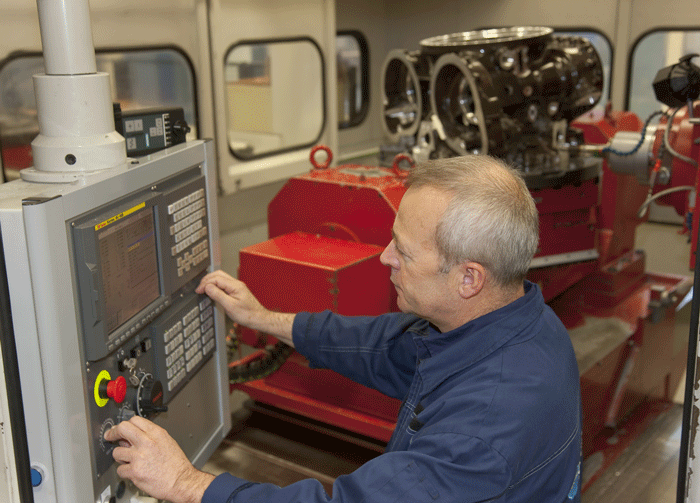05/03/2011 – Following the interview with Alain Rolland, where the Senior VP outlined the core approach of Eurocopter in shaping its approach to manufacturing for sustainability, SLD visited the factory to view some concrete examples of the approach.Pierre Maret, the head of the Development Center for Excellence, focused on the shift in the design of the Puma to the Super Puma as a core example of the evolution of the product for enhanced sustainability. And as well he provided a tour of the” Plateau” teams whereby development and manufacturing engineering approaches are correlated through concurrent engineering.
(For the earlier interview see https://www.sldinfo.com/?p=16682).
Maret provided a very clear example of the core point of Rolland. Rolland had emphasized:
The key is to reduce the number of parts necessary to operate the aircraft; less parts, more reliability, less maintenance. Getting the dynamic systems and components simplified is a key part of the process. Reducing the number of parts is beneficial in many respects, notably safety as well. If you reduce the number of moving helicopter parts, you reduce the risk of failure and enhance safety and reliability.
Maret focused on the Puma versus the Super Puma main rotor system in terms of key parts simplification. He showed the key linkage between the rotors and the motors for the Puma and highlighted the bearings, the interfaces and the lubrication device, which provided a key link.
 Building the Super Puma Credit: Eurocopter
Building the Super Puma Credit: Eurocopter
Then he showed the same linkage for the Super Puma. Bearings and lubrication devices had been eliminated along with the interfaces with a significant reduction in moving parts. Obviously, less parts, removing the bearing joints etc. replaced by elastomeric joint provided a simpler, cleaner system with significant gains in reliability and maintainability. This is a clear example of why new platforms can be significant advances in terms of reliability and sustainability over older platforms.
SLD: Could you explain the basic approach to manufacturing for sustainability?
Maret: The basic principle is to reduce the interfaces. So in terms of design, it’s to integrate as many functions as possible. So, it’s what we intend to do more and more. Instead of single function parts, we tried to integrate many, many functions on the same part. And this is possible because of advanced technology.
SLD: The approach is to remove several parts that were individual before but now are simplified into manufacturing a single part.
Maret: Yes. An example of simplification and its result can be seen with the Tiger gearbox. We have integrated the bearing raceway directly on the gear shaft. So the raceway of the bearing is machined directly onto the gears.
SLD: And it used to be a separate part?
Maret: Yes. Thank to this design, inner ring, nut and locking devices have been deleted.. By such a design, you avoid fretting corrosion between the bearing and the shaft. So thanks to that, you can increase the time between overhaul and you increase the reliability.
SLD: So, you’ve removed several parts that were individual before, so you’re manufacturing a single part.
Maret: Yes. So we reduce the interfaces, which significantly reduces reliability problems. To do that, it was necessary to integrate bearing suppliers technology and to develop a special heat treatment such as deep nitriding technology.You do this in order to increase the hardness and practical strengths of the parts, both for raceway and tooth for the gears. And the technology of the bearing supplier is now integrated into our business process. Moreover, in order to increase the reliability and safety specs, this heat treatment allows being able to run after total loss of lubrication in the gearbox. So thanks to this heat treatment, it’s possible to run with a long time without oil.
SLD: We are talking about the Tiger; is it the same for civilian helos?
Maret: We use the same technology for military, as well as civil aircraft.
SLD: We are now looking at Puma versus Super Puma main rotor hub technology. How much parts simplification from the 1970s to early 1990s?
Maret: We have reduced by a factor of about 3 the number of parts in the Super Puma compared to the original Puma. Fast-forward to the Super Puma and you have a totally different situation. You do the repairs external to the system; you do not have the same breakdown of parts requirements. You have significantly reduced the parts and the interfaces, which mean those items no longer have to be maintained.
SLD: Could you describe the engineering process, which supports manufacturing for sustainability?
Maret :We use a “Plateau” system or a concurrent engineering approach. To create a simplified product requires complex integrated engineering. So, we integrate more and more functions, but to say the design is more and more simple, but on the other hand technology needed programs are more and more complex. We design and at the same time, we design the process. So we build teams around functions that design improvements, the process and integrated with manufacturing innovations as well. You have to produce to output to see the outcome that you want to get.


